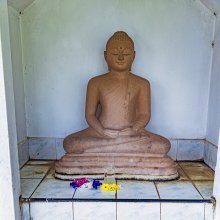Kuti, Kutī, Kuṭi, Kuṭī, Kūṭi, Kūti: 25 definitions
Introduction:
Kuti means something in Buddhism, Pali, Hinduism, Sanskrit, the history of ancient India, Marathi, Hindi, biology, Tamil. If you want to know the exact meaning, history, etymology or English translation of this term then check out the descriptions on this page. Add your comment or reference to a book if you want to contribute to this summary article.
Images (photo gallery)
In Hinduism
Purana and Itihasa (epic history)
Source: Cologne Digital Sanskrit Dictionaries: The Purana Index1) Kūṭi (कूटि).—One of the twenty Sutapa gaṇas.*
- * Vāyu-purāṇa 100. 15.
2) Kūti (कूति).—A Jayādeva*
- * Brahmāṇḍa-purāṇa III. 3. 6; 4. 2; Vāyu-purāṇa 66. 6.

The Purana (पुराण, purāṇas) refers to Sanskrit literature preserving ancient India’s vast cultural history, including historical legends, religious ceremonies, various arts and sciences. The eighteen mahapuranas total over 400,000 shlokas (metrical couplets) and date to at least several centuries BCE.
Kavya (poetry)
Source: archive.org: Naisadhacarita of SriharsaKuṭī (कुटी) refers to the “nostril” or “hut”, and is mentioned in the Naiṣadha-carita 18.9

Kavya (काव्य, kavya) refers to Sanskrit poetry, a popular ancient Indian tradition of literature. There have been many Sanskrit poets over the ages, hailing from ancient India and beyond. This topic includes mahakavya, or ‘epic poetry’ and natya, or ‘dramatic poetry’.
Vastushastra (architecture)
Source: Brill: Śaivism and the Tantric Traditions (architecture)Kuṭī (कुटी) refers to a “hut”, according to the Mohacūrottara (verse 4.234-243).—Accordingly, [while describing the construction of the maṭha]—“[...] At a distance of 1½-times the previously given distance, and half that, as is suitable, is a single maṭhikā, in the form of a set of four awnings. The storeys are as have already been taught. If money is lacking, a hut (kuṭī) is approved. [...]”.

Vastushastra (वास्तुशास्त्र, vāstuśāstra) refers to the ancient Indian science (shastra) of architecture (vastu), dealing with topics such architecture, sculpture, town-building, fort building and various other constructions. Vastu also deals with the philosophy of the architectural relation with the cosmic universe.
In Buddhism
Theravada (major branch of Buddhism)
Source: Dhamma Dana: Pali English GlossaryF (Hut, little house, lodging).
This term is generally utilised for designating the small temporary and therefore rudimentary dwelling that each bhikkhu built for himself when he boarded in a spot for a short span. Nowadays, most of bhikkhus being settled down within monasteries, rare are the ones who live in kutis.
Theravāda is a major branch of Buddhism having the the Pali canon (tipitaka) as their canonical literature, which includes the vinaya-pitaka (monastic rules), the sutta-pitaka (Buddhist sermons) and the abhidhamma-pitaka (philosophy and psychology).
Mahayana (major branch of Buddhism)
Source: archive.org: Bulletin of the French School of the Far East (volume 5)Kuṭi (कुटि) [?] [or Kuci ?] (in Chinese: Kieou-tche) is the name of an ancient kingdom associated with Pūrvabhadrapadā (or Pūrvabhadrapadānakṣatra) and Uttarabhadrapadā (or Uttarabhadrapadānakṣatra), as mentioned in chapter 18 of the Candragarbha: the 55th section of the Mahāsaṃnipāta-sūtra, a large compilation of Sūtras (texts) in Mahāyāna Buddhism partly available in Sanskrit, Tibetan and Chinese.—Chapter 18 deals with geographical astrology and, in conversation with Brahmarāja and others, Buddha explains how he entrusts the Nakṣatras [e.g., Pūrvabhadrapadā and Uttarabhadrapadā] with a group of kingdoms [e.g., Kuṭi] for the sake of protection and prosperity.

Mahayana (महायान, mahāyāna) is a major branch of Buddhism focusing on the path of a Bodhisattva (spiritual aspirants/ enlightened beings). Extant literature is vast and primarely composed in the Sanskrit language. There are many sūtras of which some of the earliest are the various Prajñāpāramitā sūtras.
General definition (in Buddhism)
Source: Wisdom Library: BuddhismKuti means hut or home for a monk.
Source: Amaravati: Glossary(Pali, Thai) hut; typical abode of a forest monastery bhikkhu.
India history and geography
Source: Cologne Digital Sanskrit Dictionaries: Indian Epigraphical GlossaryKuṭī.—(IE 8-8), a factory; cf. nīla-kuṭī. (LL), a Buddhist temple; an abbreviation of gandhakuṭī. Note: kuṭī is defined in the “Indian epigraphical glossary” as it can be found on ancient inscriptions commonly written in Sanskrit, Prakrit or Dravidian languages.

The history of India traces the identification of countries, villages, towns and other regions of India, as well as mythology, zoology, royal dynasties, rulers, tribes, local festivities and traditions and regional languages. Ancient India enjoyed religious freedom and encourages the path of Dharma, a concept common to Buddhism, Hinduism, and Jainism.
Biology (plants and animals)
Source: Google Books: CRC World Dictionary (Regional names)1) Kuti in India is the name of a plant defined with Ardisia solanacea in various botanical sources. This page contains potential references in Ayurveda, modern medicine, and other folk traditions or local practices It has the synonym Bladhia solanacea (Roxb.) Nakai (among others).
2) Kuti is also identified with Casearia esculenta It has the synonym Guidonia esculenta Baill. (etc.).
3) Kuti in Philippines is also identified with Solanum nigrum It has the synonym Solanum nigrum Tausch ex Dunal (etc.).
4) Kuti in Tanzania is also identified with Pouteria adolfi-friedericii It has the synonym Aningeria adolfi -friedericii (Engl.) Robyns & G.C.C. Gilbert subsp. australis J.H. Hemsl..
Example references for further research on medicinal uses or toxicity (see latin names for full list):
· Opera Botanica (1993)
· A Flora of North America (1838)
· Flora of Bermuda (1918)
· Proceedings of the Indian Academy of Sciences (1981)
· Feddes Repertorium (1988)
· Pakistan Journal of Botany (1982)
If you are looking for specific details regarding Kuti, for example chemical composition, extract dosage, diet and recipes, health benefits, side effects, pregnancy safety, have a look at these references.

This sections includes definitions from the five kingdoms of living things: Animals, Plants, Fungi, Protists and Monera. It will include both the official binomial nomenclature (scientific names usually in Latin) as well as regional spellings and variants.
Languages of India and abroad
Pali-English dictionary
Source: BuddhaSasana: Concise Pali-English Dictionarykuṭi : (f.) a hut.
Source: Sutta: The Pali Text Society's Pali-English DictionaryKuṭī, (kuṭi°) (f.) any single-roomed abode, a hut, cabin, cot, shed Vin. III, 144 (on vehāsa-kuṭī see vehāsa & Vin. IV, 46); Sn. 18, 19; Pv. II, 28; VvA. 188, 256 (cīvara°, a cloak as tent). See also kappiya°, gandha°, paṇṇa°, vacca°.

Pali is the language of the Tipiṭaka, which is the sacred canon of Theravāda Buddhism and contains much of the Buddha’s speech. Closeley related to Sanskrit, both languages are used interchangeably between religions.
Marathi-English dictionary
Source: DDSA: The Molesworth Marathi and English Dictionarykuṭī (कुटी).—f (S) A hut. In comp. as parṇakuṭī-tṛṇakuṭī- vavallikuṭī-latākuṭī.
--- OR ---
kuṭī (कुटी).—f (kuṭaṇēṃ) Fragments or powder (of dried fish &c.) 2 (Humorously.) Beating. Ex. āja suṭī udyāṃ kuṭī. v kāḍha g. of o. A saying amongst schoolboys.
Source: DDSA: The Aryabhusan school dictionary, Marathi-Englishkuṭī (कुटी).—f A hut. Powder (of dried fish, &c.).
Marathi is an Indo-European language having over 70 million native speakers people in (predominantly) Maharashtra India. Marathi, like many other Indo-Aryan languages, evolved from early forms of Prakrit, which itself is a subset of Sanskrit, one of the most ancient languages of the world.
Sanskrit dictionary
Source: DDSA: The practical Sanskrit-English dictionaryKuṭi (कुटि).—[kuṭ-in]
1) The body.
2) A tree. -f.
1) A cottage, hut; Bhāgavata 1.71.16.
2) A curve, bend.
Derivable forms: kuṭiḥ (कुटिः).
--- OR ---
Kuṭī (कुटी).—
1) A curve.
2) A cottage, hut; प्रासादीयति कुट्याम् (prāsādīyati kuṭyām) Sk.; Manusmṛti 11.73; पर्ण°, अश्व° (parṇa°, aśva°) &c.
3) A vessel with openings used for fumigation.
4) A nosegay
5) A kind of perfume (murā).
6) Spirituous liquor.
7) A bawd, procuress.
8) A bower (latāgṛha); कुटीषु गोपीरुचि- रासु योऽर्कभूतटीषु गोपाल इति श्रुतोऽचरत् (kuṭīṣu gopīruci- rāsu yo'rkabhūtaṭīṣu gopāla iti śruto'carat) Viś. Guṇā.461.
Source: Cologne Digital Sanskrit Dictionaries: Edgerton Buddhist Hybrid Sanskrit DictionaryKuṭi (कुटि).—or kuṭī, f. (m. or nt. modifiers, in -aṃ, acc. sg., [Prātimokṣasūtra des Sarvāstivādins] 480.8—9; or MIndic for -āṃ?), (1) as in Sanskrit, hut, cell, especially of a monk: Divyāvadāna 338.22 (tasya) kuṭiḥ śūnyāvatiṣṭhati; Avadāna-śataka ii.136.8; of leaves, a temporary shelter, parṇikāṃ kuṭim abhinirmāya Divyāvadāna 574.6; parṇa-kuṭiṃ kṛtvā Avadāna-śataka i.262.14; [Page185-a+ 71] in Mahāvyutpatti 5678 kuṭi- (v.l. kuṭī°, also v.l. in Mironov)-mahaḥ, cell-festival or according to Tibetan vihāra-(monastery-) festival (gtsug lag khaṅ gi dus ston; var. gtsug log gi etc.); similarly Chin., sūtra-hall feast; according to Japanese, a feast or ceremony celebrating completion of a new temple-building; tasya dharmabhāṇakasya caṅkramakuṭīm upasaṃkramiṣyāmi Saddharmapuṇḍarīka 475.1—2, I will go to that preacher's hall of promenade (?); (2) in maśaka-kuṭī, Mahāvyutpatti 9002, according to Tibetan sbraṅ skyabs, insect-protection ([Boehtlingk and Roth] conjecture, a whisk to brush off flies; but Chin. mosquito-netting); (3) straw or the like, as fodder for a horse (see Turner, Nepalese Dict. s.v. kuṭuro): Divyāvadāna 510.18 tuṣān kuṭiṃ cānuprayacchati (to a horse); 511.19 tuṣāś ca kaṭi (q.v.) sakaṇṭaṃ bhakṣitavyam.
--- OR ---
Kuṭī (कुटी).—see kuṭi.
Source: Cologne Digital Sanskrit Dictionaries: Shabda-Sagara Sanskrit-English DictionaryKuṭi (कुटि).—mf. (-ṭiḥ-ṭiḥ or -ṭī) A house. m.
(-ṭiḥ) 1. A tree. 2. The body. 3. Curvature, a curve. E. kuṭ to be crooked, i Unadi aff.
Source: Cologne Digital Sanskrit Dictionaries: Benfey Sanskrit-English DictionaryKuṭī (कुटी).—[kuṭ + ī], f. 1. A hut, [Mānavadharmaśāstra] 11, 72. 2. A vessel serving for fumigation, [Suśruta] 2, 33, 18.
Source: Cologne Digital Sanskrit Dictionaries: Cappeller Sanskrit-English DictionaryKuṭi (कुटि).—[feminine] curve, contraction (—°); hut, cottage.
--- OR ---
Kuṭī (कुटी).—[feminine] = kuṭi.
Source: Cologne Digital Sanskrit Dictionaries: Monier-Williams Sanskrit-English Dictionary1) Kuṭī (कुटी):—[from kuṭa > kuṭ] a f. [gana] gaurādi ([Gaṇaratna-mahodadhi 47]).
2) Kuṭi (कुटि):—[from kuṭ] a f. ‘a curvature, curve’ See bhṛk, bhruk
3) [v.s. ...] a hut, cottage, hall, shop (= kuṭī q.v.), [Uṇādi-sūtra iv, 144]
4) [v.s. ...] m. a tree, [cf. Lexicographers, esp. such as amarasiṃha, halāyudha, hemacandra, etc.]
5) [v.s. ...] the body, [cf. Lexicographers, esp. such as amarasiṃha, halāyudha, hemacandra, etc.]
6) Kuṭī (कुटी):—[from kuṭ] b f. ‘a curvature, curve’ See bhṛk, bhruk
7) [v.s. ...] a hut, cottage, house, hall, shop, [Mahābhārata; Rāmāyaṇa] etc.
8) [v.s. ...] a room with openings used for fumigations, [Caraka; Suśruta]
9) [v.s. ...] a bawd, [cf. Lexicographers, esp. such as amarasiṃha, halāyudha, hemacandra, etc.]
10) [v.s. ...] a nosegay, bundle or tuft of flowers or vegetables, [cf. Lexicographers, esp. such as amarasiṃha, halāyudha, hemacandra, etc.]
11) [v.s. ...] a kind of perfume (commonly Murā), or = surā (spirituous liquor), [cf. Lexicographers, esp. such as amarasiṃha, halāyudha, hemacandra, etc.]
12) Kuṭi (कुटि):—[from kuṭa-hārikā] b etc. See, [ib.]
13) Kuṭī (कुटी):—[from kuṭila] c etc. See, [ib.]
14) Kūṭī (कूटी):—[varia lectio] for kūdī.
Source: Cologne Digital Sanskrit Dictionaries: Yates Sanskrit-English DictionaryKuṭi (कुटि):—[(ṭiḥ-ṭī)] 2. m. 3. f. A house. m. A tree; the body; a curve.
Source: DDSA: Paia-sadda-mahannavo; a comprehensive Prakrit Hindi dictionary (S)Kuṭī (कुटी) in the Sanskrit language is related to the Prakrit word: Kuḍī.
[Sanskrit to German]
Sanskrit, also spelled संस्कृतम् (saṃskṛtam), is an ancient language of India commonly seen as the grandmother of the Indo-European language family (even English!). Closely allied with Prakrit and Pali, Sanskrit is more exhaustive in both grammar and terms and has the most extensive collection of literature in the world, greatly surpassing its sister-languages Greek and Latin.
Hindi dictionary
Source: DDSA: A practical Hindi-English dictionaryKuṭī (कुटी):—(nf) a cottage, hut, hermitage; cut grass and weeds (for cattle to eat).
...
Kannada-English dictionary
Source: Alar: Kannada-English corpusKuṭi (ಕುಟಿ):—[noun] = ಕುಟಿಕೆ [kutike].
--- OR ---
Kuṭi (ಕುಟಿ):—
1) [noun] a turning; a curvature; a curve 2) a little house with a thatched roof; a hut.
2) [noun] a vessel used for fumigation.
3) [noun] a bunch of flowers; a bouquet; a nosegay.
4) [noun] the whole physical structure and substance of a human being, animal; the body.
5) [noun] a perennial woody plant rising from the ground with a single supporting trunk or stem; a tree.
--- OR ---
Kūṭi (ಕೂಟಿ):—[noun] a joint or device on which a door, gate, lid, etc. swings; a hinge.
Kannada is a Dravidian language (as opposed to the Indo-European language family) mainly spoken in the southwestern region of India.
See also (Relevant definitions)
Starts with (+255): Kutakannatissa, Kuti kata, Kuti-ayakattu, Kuti-erranatu, Kuti-kani-misa, Kuti-karcippi, Kuti-kuti, Kuti-makkalmaniyam, Kuti-nilaiuraittal, Kuti-ninkatevatanam, Kuti-ninkatiruvitaiyattam, Kuti-tankikol, Kuti-varanilam, Kuti-y-ottu-p-pun-tu, Kuticai, Kuticaitukku, Kuticaka, Kuticakam, Kuticakan, Kutical.
Ends with (+195): Aklikuti, Akuti, Ambukukkuti, Ankutiyinkuti, Anniyakkuti, Aryabhrikuti, Asakuti, Ashvakuti, Avakrayakuti, Avi-nankuti, Aykkuti, Baddhabhrukuti, Bakuti, Bhaisikuti, Bhakuti, Bhandarakhala-dhukuti, Bhirakuti, Bhrakuti, Bhramakuti, Bhramantkuti.
Full-text (+255): Gandhakuti, Granthakuti, Kuticara, Kudi, Jangamakuti, Bhrakuti, Mashakakuti, Patakuti, Kutimaya, Trinakuti, Bhrikuti, Kutikuta, Vasahkuti, Caka, Pannakuti, Bhramatkuti, Kutikrita, Kuticaka, Bhrukuti, Kuti-kuti.
Relevant text
Search found 52 books and stories containing Kuti, Kutī, Kuṭi, Kuṭī, Kūṭi, Kūti, Kūṭī; (plurals include: Kutis, Kutīs, Kuṭis, Kuṭīs, Kūṭis, Kūtis, Kūṭīs). You can also click to the full overview containing English textual excerpts. Below are direct links for the most relevant articles:
Bodhisattvacharyavatara (by Andreas Kretschmar)
Text Section 74 < [Khenpo Chöga’s Oral Explanations]
Sripura (Archaeological Survey) (by Bikash Chandra Pradhan)
Ananda-Prabha-Kuti-Vihara < [Chapter 2 - The Architectural Panorama]
Stone Images (1): Buddhist Images < [Chapter 3 - Sculptural Programme]
Svastik Vihara < [Chapter 2 - The Architectural Panorama]
Banner of the Arahants (by Bhikkhu Khantipalo)
Chapter 6 - The Life Of Bhikkhus
Introduction < [Chapter 8 - Westerners In The Sangha]
Vakyapadiya of Bhartrihari (by K. A. Subramania Iyer)
Verse 2.207 < [Book 2 - Vākya-kāṇḍa]
Verse 3.13.25 < [Book 3 - Pada-kāṇḍa (13): Liṅga-samuddeśa (On Gender)]
Bhakti-rasamrta-sindhu (by Śrīla Rūpa Gosvāmī)
Verse 2.5.66 < [Part 5 - Permanent Ecstatic Mood (sthāyī-bhāva)]
Verse 2.5.63 < [Part 5 - Permanent Ecstatic Mood (sthāyī-bhāva)]
Verse 3.4.26 < [Part 4 - Parenthood (vātsalya-rasa)]
Tiruvaymoli (Thiruvaimozhi): English translation (by S. Satyamurthi Ayyangar)
Pasuram 4.1.9 < [Section 1 - First Tiruvaymoli (Oru nayakamay)]
Pasuram 3.4.11 < [Section 4 - Fourth Tiruvaymoli (Pukalum nal oruvan)]
Pasuram 5.10.10 < [Section 10 - Tenth Tiruvaymoli (Piranta arum)]


